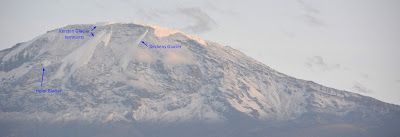Tuesday, December 8, 2015
Snowy November, slope glacier changes
During the month of November, net snow accumulation on the Northern Ice Field amounted to 19 cm. During this very strong El Niño year we expect additional snowfall through at least December, as the short rains continue. The image above shows fresh snowcover as seen from Moshi just after sunrise this morning (8 December 2015); thanks as always to Simon at SENE for keeping us updated.
Some readers may recall seeing other photos from Moshi posted here previously. Despite slight differences in lighting and snowline elevation, at first glance these appear quite similar. However, even at considerable distance, with thin snowcover, and a short 1-2 year timespan, changes in the glaciers are apparent upon close inspection.
Here are links to approximately the same view, one year ago (5 Dec. 2014; lower photo) and two years ago (24 Nov. 2013).
Three locations at which change is evident are labeled on today's image, including 1) Heim Glacier, a remnant of ice which was recently contiguous with ice to the left, and not long ago flowed nearly from the crater rim (as the Deckens does today); 2) Kersten Glacier, showing overall shrinkage in area with increasing separation of the upper and the slope remnants; and 3) Deckens Glacier, which will very soon become disconnected from the upper portion. All of these glaciers formerly comprised the Southern Ice Field.
Recession of other glaciers on Kilimanjaro also continues, based on annual field observations, GPS mapping, and imagery. The Furtwängler Glacier, for example, has been reduced to 4 fragments and continues to thin. At the Northern Ice Field - Kibo's largest ice body - the vertical margins continue retreating (ablating), and thinning of the glacier in some locations is creating new holes. Somewhat surprisingly however, this is not the case at the highest, flat section of the glacier. At the AWS, the 19 cm accumulation increase during November brings the ice surface to exactly the same elevation as it was on 1 Oct. 2011, meaning that the specific mass balance of that section has been neutral for 4 years! This portion of the Northern Ice Field will almost certainly be the last ice to disappear from the mountain.
Subscribe to:
Post Comments (Atom)




No comments:
Post a Comment